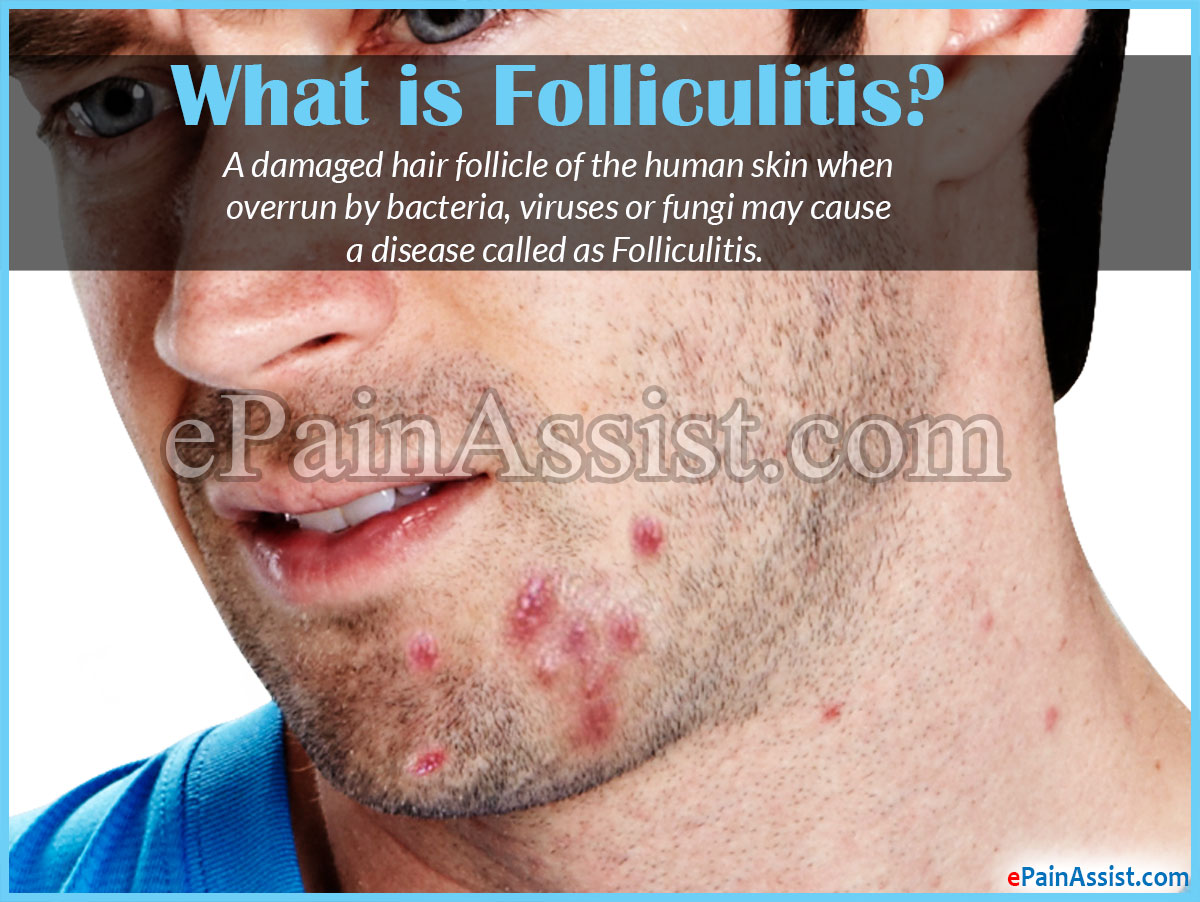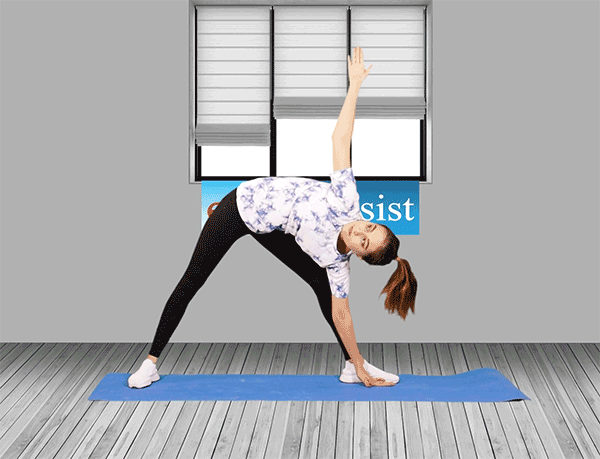What is Folliculitis?
A damaged hair follicle of the human skin when overrun by bacteria, viruses or fungi may cause a disease called as Folliculitis. When it affects the upper extent of the body, next to the follicle, it is superficial (as shown in the above image). But, when it affects the inner part of the follicle, it affects the complete follicle of hair.

Folliculitis is a general disease of the skin (bacterial infection or fungal or viral) that inflames the hair follicles on the skin. Initially, there are white headed pimples or red bumps in the region of hair follicles. The miniature sack that grows hair is called a hair follicle. The infection of folliculitis if not taken care of extends and becomes non curing crusty sores.
Though the condition is not deadly, it will cause irritation, pain and discomfort. If the infection is severe then it may cause loss of hair permanently and scarring occurs.
If the infection is not so severe, in those cases it can be cured within a short time by necessary self-management. But, severe or chronic folliculitis needs to be treated by the expert skin specialist.
A few types of this disorder are identified as hot tub rash, barber’s itch and razor bumps.
Is Folliculitis Contagious?
Generally, the disease of folliculitis is benign and largely self-limited and non-contagious skin disease.
Even though folliculitis is not fatal, it surely in some cases can be transmitted. Folliculitis transmits from one person to another person in case of skin contact, sharing razors, and sharing bath tubs.
The non-infectious or sterile forms are those that attack the person through virus, fungus or bacterium. Some people again are prone to the disease of folliculitis due to health condition taken together, history of exposure and altered immune conditions. Other biased conditions of the skin such as dry skin condition or eczema also cause the disease of folliculitis.
The bacteria of folliculitis are rather infectious and can catch person to person. This is the reason why you should avoid sharing towels, razors or clothes till the infection is treated successfully.
Does Folliculitis Affect the Entire Body?
The abrasion of the folliculitis attacks the human back, chest, and legs. Other areas are the neck, face, buttocks, and thighs. Though not impossible, the cases of whole body infection are very much rare. The areas such as palms, soles, mouth or eyes, remain unaffected by folliculitis.
Few points to remember about folliculitis:
- It is very general and not dangerous.
- Appears as pointed tiny bumps.
- Folliculitis attacks people in all age groups: from kids to adults.
- Commonly occur in teenagers and older kids or young adults.
- Plentiful, red, small, tiny bumps in the hair follicles areas.
- Commonly appears on the back, buttocks, chest, and legs.
- Generate the appearance of “chicken skin” or “goose bump” on the skin.
- Folliculitis can be seen in healthy people also.
- Most cases are completely curable.
- Clears out without treatment, most of the time.
- May sometimes need regular therapy and follow-ups.
- Frequently treated by applying anti-bacterial agents such as benzoyl peroxide.
- Challenging cases require antibiotic drugs to get cured.
What are the Causes of Folliculitis?
Folliculitis can be caused by multiple organisms. Folliculitis is generally caused from the staphylococcus aureus, a bacterial infection of hair follicles. Fungi and viruses can also cause folliculitis. In some cases ingrown hair inflammation can cause the disease of folliculitis.
The disease of folliculitis can range from mild to severe depending on the amount of the hair follicle involved. Intense Folliculitis, as a rule, is very severe.
The densest follicles on the scalp occur on the body and spread everywhere, but the lips, palms and mucous membranes. All the follicles are not equally prone to the risk of infection. The damaged follicles are more susceptible to infection.
The most frequent causes that lead to damage of a hair follicle are:
- Erosion from tight clothing and razor.
- Sweat and heat, generally caused by rubber gloves or waterproof boots.
- Some of the skin ailments, such as acne and dermatitis.
- Skin wounds, such as surgical or scrapes.
- Some coverings on your skin, for example, adhesive tape or plastic dressings.
What are the Signs and Symptoms of Folliculitis?
The below are the signs and symptoms of folliculitis:

- A group of red tiny bumps or pimples with a white-head around created around the hair follicles.
- Blister filled with pus that crust over and break open.
- Red and swollen skin.
- Burning or itchy skin.
- Softness or pain.
- A large inflamed mass or bump.
When to Consult With a Doctor for Folliculitis?
If the symptoms are widespread, and do not show any sign of improvement, consult skin specialist doctor immediately. There might be necessities of special mediation, such as antifungal or antibiotics in order to cure the problem.
What are the Different Types of Folliculitis?
Types of folliculitis range from mild or superficial to dense or deep folliculitis and each of these mild and deep folliculitis are sub divided into many types which are explained below:
Types of Superficial Folliculitis
Superficial types of folliculitis comprises of:
- Bacterial Folliculitis: This is nothing uncommon, rather a common disease, marked by white, itchy, pus filled bumps. If bacterial disorder distresses the beard areas, it is named as Barber’s itch. It comes about when the follicles of hair get bacterial infections, normally Staphylococcus Aureus that lives all the time on skin. But they generate problem only when they go into the body through any wound or cut.
- Hot Tub Folliculitis or Pseudomonas Folliculitis: This type of bacteria may infect you in different places such as in hot water of pools or of tubs where pH levels and chlorine levels are not well balanced. The possibilities of development itchy and round bumps within 3-4 days of the exposure are almost certain. Later, they develop tiny blisters full of pus. The rash becomes bad where the swimsuits with polluted water get in touch with skin, like the thighs or back.
- Barber’s Itch or Pseudofolliculitis Barbae Folliculitis: This type of inflammation is caused by ingrown hairs and mainly affects men with black complexion when shaving. It is visible on the surface of the neck and face. People with bikini waxes also develop this type of itch in and around the groin part. This form of itch may leave behind dark and raised marks called keloids.
- Pityrosporum Folliculitis: The teens and the adult people are susceptible to this type of Folliculitis. It’s caused by a mushroom infection and generates unceasing, itchy and red blister filled with pus on the chest and the back. Sometimes these are also prominent on the shoulders, neck, face and the upper arms.
Types of Deep Folliculitis
When the entire hair follicle is attacked, it is called deep folliculitis. It can be of various forms:
- Sycosisbarbae: This type of folliculitis affects men when they began to shave. At first, little blisters with pus come out on the chin, jaw, and upper lip. Over days, they are rampant as shaving continues. Rigorous Sycosisbarbae may give rise to scarring.
- Gram Negative Folliculitis: The folliculitis of this kind may develop after long run antibiotic treatment for curing acne. The bacteria in the nasal areas lose their control because of the antibiotics. This condition helps in growing gram negative bacteria, one of the harmful organisms. In most of the cases, these bacteria do not create any problem as it goes back to normal position soon after the antibiotics are stopped. But, for some people again, this bacterium spreads in the region of the mouth and nose that may pose severe problems of acne.
- Boils or Furuncles: When the hair follicles are badly contaminated with the staph bacteria, these kinds of folliculitis develop. Usually, boil suddenly appears as an aching red or pink bump. The skin surrounding the affected areas may also be swollen and red. The bump or the lump is filled with pus and gets bigger and bigger. The bump then fills with pus and grows larger and more painful before it finally rip apart and drained. Small boils are normally healed, leaving no scar. A large boil, on the other hand, may be scary after being treated.
- Carbuncles: When a few boils or furuncles cluster together, it is called a carbuncle, which appears usually on the neck and shoulder, thighs or back. It is a severe and deeper kind of infection as compared to the single boil. A carbuncle causes a deeper and more severe infection than the damage a single boil does. Consequently, it grows slowly and heals slowly, and when cured it leaves a scar.
- Eosinophilic folliculitis: This type of folliculitis mostly has an effect on people with HIV or AIDS. The Symptoms of this type include chronically inflamed patches and itching, the pus-filled sores on the face, neck, scalp, and on the upper chest. The open skin infection multiplies and most of the times leave dark areas on the skin. This condition is called hyperpigmentation. Though, the real cause of the eosinophilic folliculitis is still unknown, it is assumed that some kinds of fungus might be responsible for this kind of disorder.
What are the Risk Factors for Folliculitis?
The development of folliculitis may occur to anyone. But, there are few conditions that make you more vulnerable to this disorder. These risk factors for folliculitis include:
- If you are suffering from any disease that has reduced the resistance power to infection and the important medical conditions are HIV/ AIDS, chronic leukemia, and diabetes.
- If you have dermatitis or acne, the risk of catching folliculitis is high.
- If you have a past record of skin damage because of surgery or injury.
- If you have to take long term medications of antibiotics or steroids for acne.
- If you are an overweight person.
- If you wear clothing that traps sweat and heat, such as high boots or rubber gloves you are prote to suffer folliculitis.
- If you use hot tubs which are not well maintained, the chances of catching folliculitis is very high.
- If you shave without proper hygiene.
What are the Complications for Folliculitis?
The potential complications of folliculitis consist of:
- Persistent or dispersal infection.
- Plaques or the big, inflamed patches of the skin.
- Under skin boils or furunculosis is one of the complications of folliculitis.
- Permanent damage of skin, for example, dark spots or scarring.
- Permanent loss of hair as well as damaging of hair follicles is the major complication of folliculitis.
How is Folliculitis Diagnosed?
The disease of folliculitis can be detected by skin specialists by observing the skin condition and examining the clinical history of the patient. If the normal treatment does not work, the skin specialist may take a sample of infection swabbing on the skin. After laboratory tests, the cause of infection is determined. Though rare, a skin biopsy is also done to eliminate the other causes of the diseases.
How to Get Rid of Folliculitis?
Treatment for Folliculitis:
The treatment for folliculitis depends on the intensity, the type of the folliculitis, the type of self-management you have already taken, and which kind of treatment you prefer. The infection may relapse even if the treatment works.
Usage of Drugs or Medications to Treat Folliculitis
Antibiotic Tablets or Creams that Help get Rid of Infection of Folliculitis
The doctor may prescribe mupirocin (Bactroban), an antibiotic cream for mild infections of folliculitis. But for severe cases, oral antibiotics are tried.
Shampoos, Creams or Antifungal Tablets to Defend Against Fungal Infections of Folliculitis
The antifungals are given for the yeast related infection, not for bacteria, particularly, like pityrosporum folliculitis. The application of antibiotics does not help to treat or get rid of this type of folliculitis.
Pills or Creams to Trim Down Inflammation and Get Rid of Folliculitis
The doctor may prescribe steroid creams if you are attacked with mild eosinophilic folliculitis. But in the case of severe condition oral corticosteroids are suggested. This drug might results in serious side effects and cannot be used for an extended period of time.
If the patient is affected with HIV or AIDS, they might getl relief from eosinophilic folliculitis symptoms if they follow the antiretroviral therapy.
Other Treatment Options to Get Rid of Folliculitis
Minor Surgery for Treating Folliculitis
In the case of a carbuncle or a large boil, the doctor may perform surgery for folliculitis to drain out pus by splitting. This may be a great reliever of pain and leads to a speedy recovery. It also helps reducing scarring. After the surgery, if the pus continues to come out, the doctor uses gauze to cover the area.
Light Therapy (Photodynamic Therapy) with a Medicated Cream that Help Treat or Get Rid of Folliculitis
It is also known as photodynamic therapy that helps people with the folliculitis when every other therapy fails. Six out seven people who underwent this treatment at least once showed improvement after four weeks, and the person is free from the symptoms after fifteen months since the last therapy.
Laser Therapy for Hair Removal for Folliculitis
In case, if the other therapies do not work the laser therapy might help get rid of the infection causing folliculitis. This process is costly and may need a number of therapies. It minimizes the thickness of hair in the areas that have treated and, it is permanent. The further probable outcome might be discoloration of skin, blistering and scarring.
What are the Alternative Treatments for Folliculitis?
Few of the alternative treatments to help get rid of folliculitis are:
- Allium Sativum or Garlic can be used as an alternative treatment for folliculitis as it contains antibacterial properties. Individuals, who are experiencing the symptoms of folliculitis, may consume 3 capsules of garlic oil or 3 cloves of garlic every day for better results.
- Folliculitis can be treated by using galiumaparine or cleavers as they support the lymphatic system. Patients can take it internally. It helps to cure staph sores, and lymph nodes swelling can be reduced.
- Hydrastiscanadensis or goldenseal for treating folliculitis is very much efficient to lessen inflammation and to combat against the infection. Take the help of this herb as soon as possible after experiencing the infection at the first time. Mix a little water with the powder of the root of goldenseal and make a paste. Then apply the paste on the affected or infected part of the skin.
- Echinacea is a herb which contains antibiotic properties and can be used for curing folliculitis. So, this herb can be consumed to fight the folliculitis infection.
- Essential oils like citrus bergamot (bergamot), lavandula officinalis (lavender), or thymus vulgaris (thyme) oils are beneficial for treating the problem of folliculitis. Add drops of these essential oils to water and soak a towel in it and compress it on the body part. In addition, ylanglang or melaleuca (tea tree oil) can be used for better effect.
- Adding fatty acid supplements like omega-3 fatty acids and gamma-linolenic acid (GLA) to your regular diet can help in treating folliculitis. GLA or Gamma-Linolenic acid is an Omega-6 fatty acid encourages the good growth of hair, nails and skin but it is hard to get the Omega-6 fatty acid from the diet. Blackcurrant oil, borage oil, and primrose oil are the best sources of Omega-6 fatty acid and you can take these as capsules form. Consume sardines, Alaskan Salmon, Freshly ground flaxseeds, walnuts, fortified eggs and fish oils to get enough Omega-3 fatty acids.
What are the Home Remedies for Folliculitis?
Home remedies or cures provide excellent results in the mild cases of folliculitis. Follow the below home remedies to get relief from discomfort, to prevent of spreading folliculitis or to speed up healing:

- Compressing or applying warm, damp cloth on the infected area is a good home remedy for folliculitis. Do it for a few times every day to get relief from discomfort. It also drains the area, if it bleeds or there is any soreness. You can use salt water to dampen the cloth and in order to do, add one teaspoon of table salt to two cups of water.
- Try OTC (over the counter) antibiotics. You can use different anti-infection washes, creams and gels available over the counter.
- Using gentle lotions can be a useful home remedy for folliculitis. To get relief from inflamed skin try oatmeal lotion. In addition, hydrocortisone cream which is considered as a non-prescription cure can be used and is a good home remedy for folliculitis.
Some other home remedies for treating folliculitis include:
Clean properly the affected areas of the skin. Wash gently the infected area of skin two times every day with an antibacterial soap. Always use hygienic towel and washcloth every time. Never share your washcloths or towel. Properly wash these items with soap and hot water after use them in every time.
Shield the skin. It is better to stay away from shaving. If necessary, use electric razor and wash well the skin by using warm water. Then, apply moisturizer.
What is the Recovery Period or Healing Time for Folliculitis?
The healing time or recovery period for folliculitis varies on how early the disease is detected and type of the folliculitis. If it is detected early, then this problem will be cured within 1 or 2 weeks, but deep folliculitis requires long time to heal. So, it is necessary to continue proper treatment and to avoid the triggers for folliculitis. Then it will help to fasten the recovery period.
Usually, folliculitis does not raise serious health issue, but it can leave blemish on the skin. But remember, that it can relapse in future. Though it is rare, but folliculitis can hurt the hair follicle and so the affected individual may experience hair loss permanently.
How Can Yoga Help with Folliculitis?
Many forms of yoga including asanas, pranayamas and meditation can be helpful in reducing the skin diseases including folliculitis.
- Sun salutations or suryanamaskars are a very good set of yoga poses for any kind of skin diseases including folliculitis. It has its own unique and excellent features. This particular yoga should be performed in the early morning facing the rising sun. Start your day saluting the sun. Suryanamaskar yoga consists of 12 postures and can be practiced anytime of the da but it will be beneficial if done during the sunrise.

- Practice the yoga postures or asanas such as Triangle pose, Plow pose, Child pose, Fish pose, Cobra pose and Shoulder stand which are helpful for increasing blood circulation to the skin and help prevent skin diseases like folliculitis. These postures boost up oxygenation to the overall body and are known as chest openers. All the upturned postures and forward bends enhance the blood supply to the head which helps to achieve glowing and clean skin.




- Pavanamuktasana or Wind-relieving posture is beneficial for improving digestive process. In addition, Vajrasana (Kneeling pose), Dhanurasana (Bow Pose), Alternate Nostril Breathing (Nadi shodhan pranayama), and Skull shining breathing technique (Kapal bhati pranayama) should be practiced on empty stomach for better effect. Kapal Bhati is considered as an effective detoxifying method. It is appropriately named because the meaning of ‘Kapal’ is forehead and ‘Bhati’ stands for glowing. In fact, through this powerful breathing the body gets detoxified and the first effect it shows natural shining skin.



- Meditate at least two times every day. If you meditate more, you will glow from within and without and this natural make-up will last for a long duration and it will make you more beautiful.
- You can perform fast-paced yoga exercises, for instance quick rounds of Surya namaskars or sun salutations. It will make you sweat and remove toxins naturally from the system. But only experienced students should be doing these, for beginners basic sun salutation exercises are enough to sweat them.
- Drink plenty of water to reduce skin diseases like folliculitis. Particularly lukewarm water with lemon and honey is highly beneficial to detoxify the system and to keep your skin healthy and clean.
- Include fresh vegetables and fruits which are rich in vitamin C to your daily diet. Especially, papaya offers wonderful effect to your skin and prevents conditions like folliculitis. You can consume it or can use it as face-pack or massage. In addition, potato is a good option for removing scars, dark spots, sunburn and tan.
- Avoid consuming oily food, junk food, fried and spicy food. Excessive sweets are also harmful. Instead of these foods, consume dry fruits and healthy refreshments to prevent folliculitis.
- Take enough rest. When the body gets deep rest, it shows its positive effect on the face. At least 8 hours sound sleep in every night is ideal for good health.
What is the Prognosis for Folliculitis?
The prognosis of folliculitis is excellent. Generally, folliculitis is easily treatable and receptible to cure the skin problem. Generally folliculitis is a non-contagious, self-limited, mild skin disease. But, exceptional type of folliculitis may lead to cosmetic scarring and it can be psychologically upsetting to the patient.
How to Prevent Folliculitis?
Follow the below mentioned tips to prevent and also to avoid the recurrence of folliculitis:
- Keep away from tight clothes to prevent folliculitis. They will increase rubbing between clothing and skin.
- Always wear dry rubber gloves to prevent folliculitis. Wash well your rubber gloves with water and soap after every use and dry it properly.
- Do not shave, if possible. For men, it is advisable to avoid shaving until the folliculitis is treated.
- Shave carefully in order to prevent the recurrence of folliculitis. Shave with a clean, sharp blade. An electric razor is a good option. Follow some good habits, for example:
- Before shaving, wash your face with a gentle facial cleanser using warm water.
- Use the cleansing pad or washcloth and apply gentle circular motion.
- Apply lubricating shaving gel or cream for 5 to 10 minutes before shaving to soften the hair.
- Apply moisturizer after you shave. Always shave in the direction of hair growth. It has been found that men who shave against the grain improve the rashes. You can go to experiment what works for you. In addition, you may take the help of hair-removing products, such as depilatories or can apply other hair removal methods.
- Go for only hygienic heated pools and hot tubs to avoid any kind of skin diseases including folliculitis. Clean regularly your heated pool or hot tub. You can use chlorine to get the hygienic effect.
Also Read:

